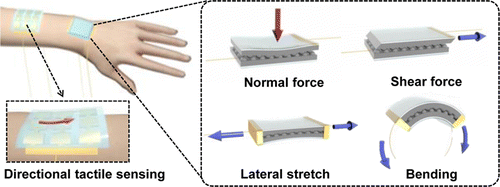New 'electronic skin' for prosthetics, robotics detects pressure from different directions

Touch can be a subtle sense, but it communicates quickly whether something in our hands is slipping, for example, so we can tighten our grip. For the first time, scientists report the development of a stretchable "electronic skin" closely modeled after our own that can detect not just pressure, but also what direction it's coming from. The study on the advance, which could have applications for prosthetics and robotics, appears in the journal ACS Nano.
Hyunhyub Ko and colleagues explain that electronic skins are flexible, film-like devices designed to detect pressure, read brain activity, monitor heart rate or perform other functions. To boost sensitivity to touch, some of them mimic microstructures found in beetles and dragonflies, for example, but none reported so far can sense the direction of stress. This is the kind of information that can tell our bodies a lot about the shape and texture of an object and how to hold it. Ko's team decided to work on an electronic skin based on the structure of our own so it could "feel" in three dimensions.
The researchers designed a wearable artificial skin made out of tiny domes that interlock and deform when poked or even when air is blown across it. It could sense the location, intensity and direction of pokes, air flows and vibrations. The scientists conclude that their advance could potentially be used for prosthetic limbs, robotic skins and rehabilitation devices.
More information: "Tactile-Direction-Sensitive and Stretchable Electronic Skins Based on Human-Skin-Inspired Interlocked Microstructures" ACS Nano, Article ASAP. DOI: 10.1021/nn505953t
Abstract
Stretchable electronic skins with multidirectional force-sensing capabilities are of great importance in robotics, prosthetics, and rehabilitation devices. Inspired by the interlocked microstructures found in epidermal–dermal ridges in human skin, piezoresistive interlocked microdome arrays are employed for stress-direction-sensitive, stretchable electronic skins. Here we show that these arrays possess highly sensitive detection capability of various mechanical stimuli including normal, shear, stretching, bending, and twisting forces. Furthermore, the unique geometry of interlocked microdome arrays enables the differentiation of various mechanical stimuli because the arrays exhibit different levels of deformation depending on the direction of applied forces, thus providing different sensory output patterns. In addition, we show that the electronic skins attached on human skin in the arm and wrist areas are able to distinguish various mechanical stimuli applied in different directions and can selectively monitor different intensities and directions of air flows and vibrations.
Journal information: ACS Nano
Provided by American Chemical Society



















